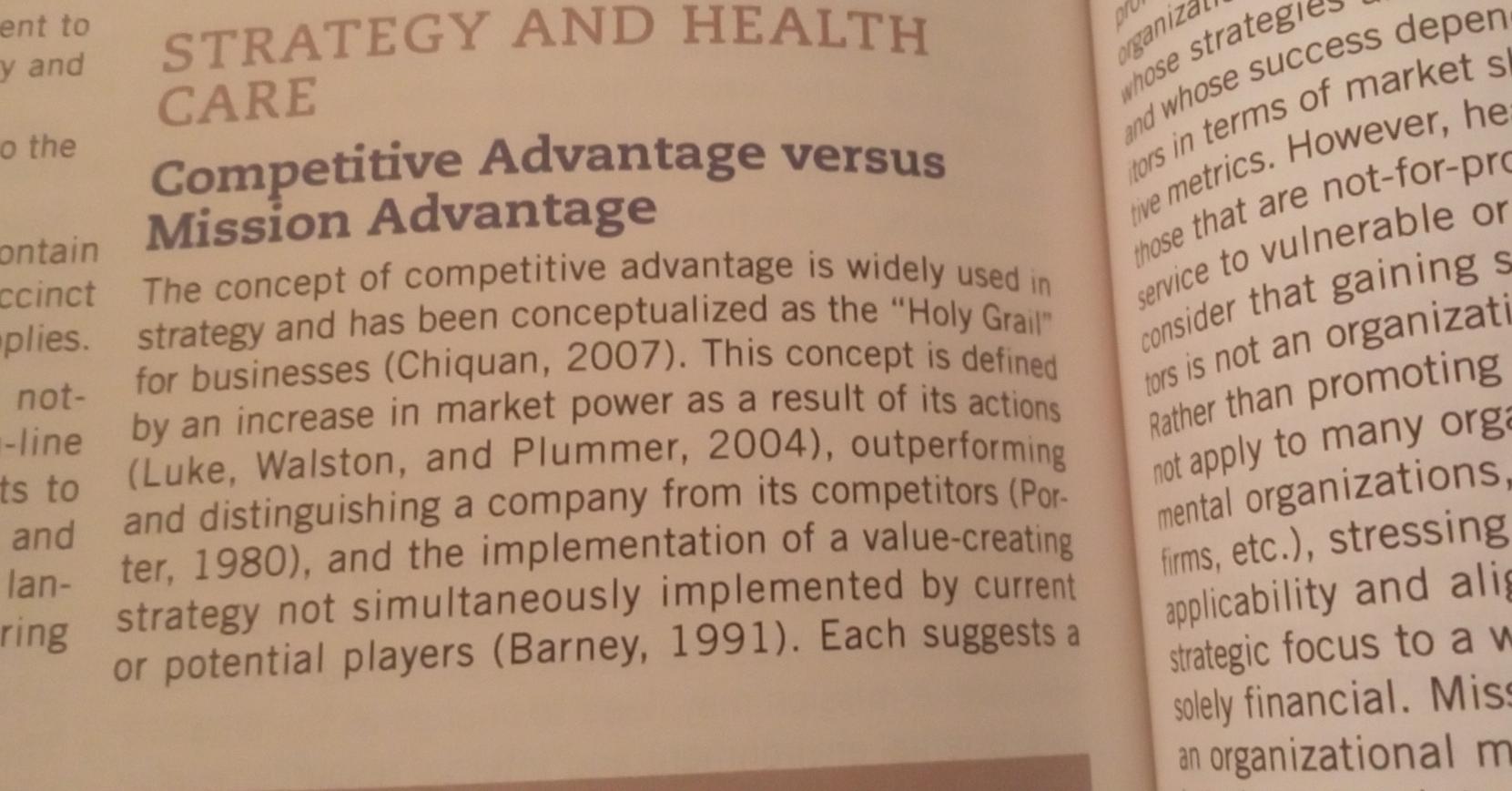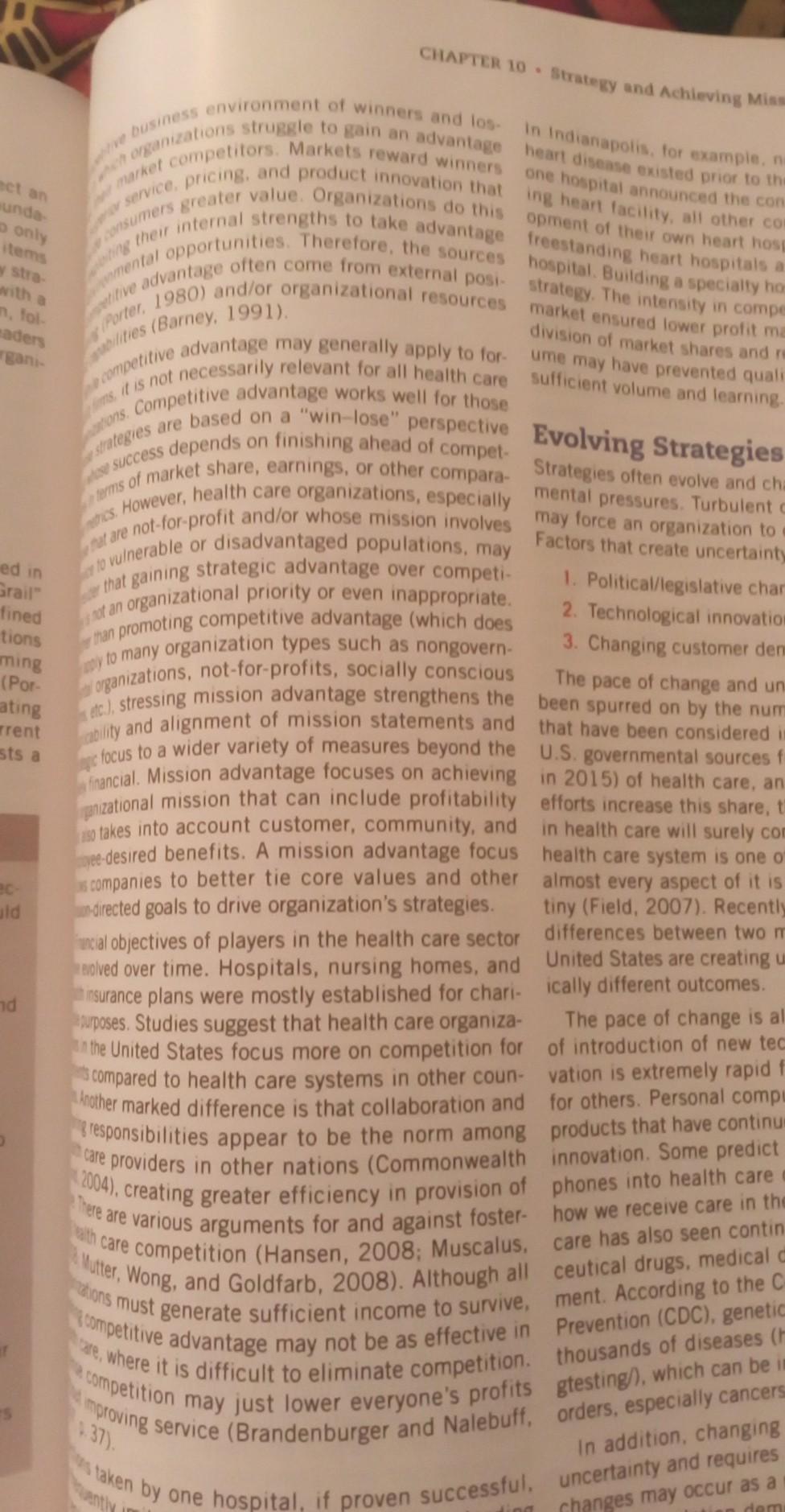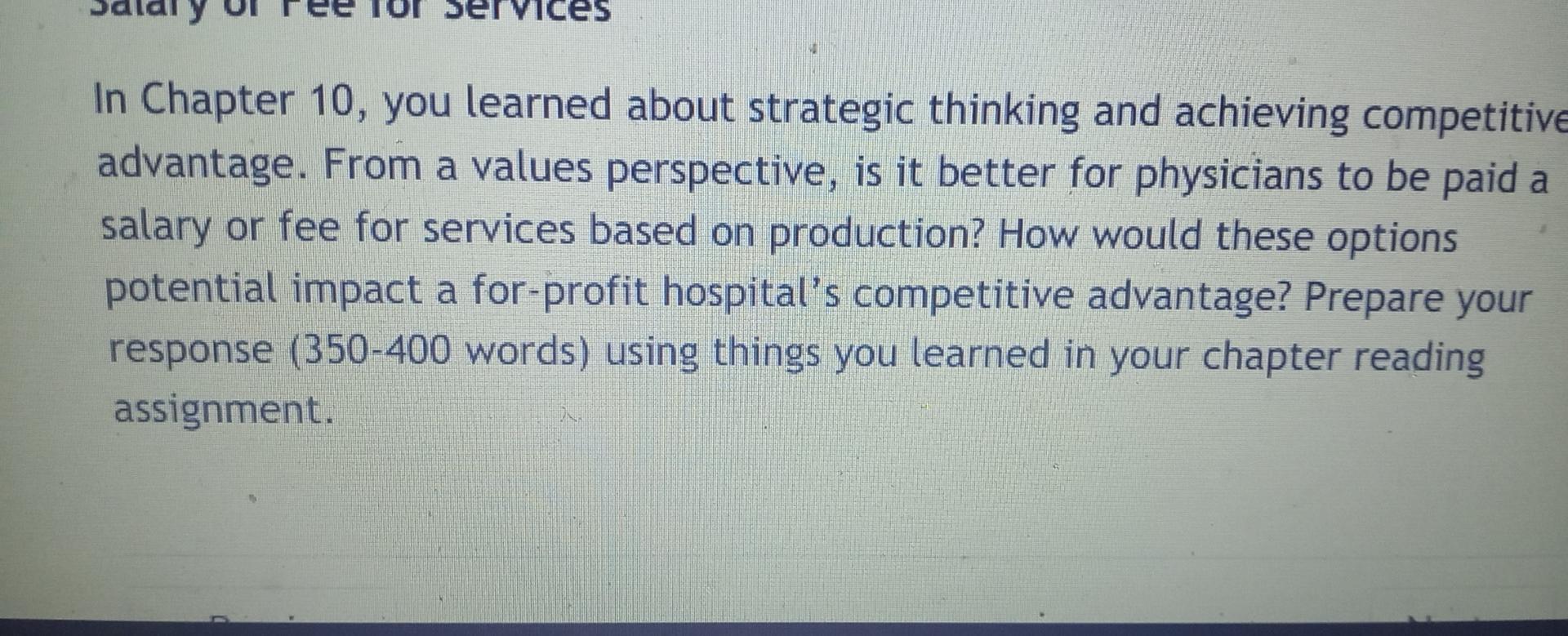Answered step by step
Verified Expert Solution
Question
1 Approved Answer
ent to y and STRATEGY AND HEALTH CARE o the Competitive Advantage versus Mission Advantage ontain ccinct not- -line ts to The concept of



ent to y and STRATEGY AND HEALTH CARE o the Competitive Advantage versus Mission Advantage ontain ccinct not- -line ts to The concept of competitive advantage is widely used in plies. strategy and has been conceptualized as the "Holy Grail" for businesses (Chiquan, 2007). This concept is defined by an increase in market power as a result of its actions (Luke, Walston, and Plummer, 2004), outperforming and distinguishing a company from its competitors (Por- ter, 1980), and the implementation of a value-creating ring strategy not simultaneously implemented by current or potential players (Barney, 1991). Each suggests a and lan- pro organiza whose strateg and whose success depen- itors in terms of market sh tive metrics. However, he those that are not-for-pro service to vulnerable or consider that gaining s tors is not an organizati Rather than promoting not apply to many orga mental organizations, firms, etc.), stressing applicability and alig strategic focus to a w solely financial. Miss an organizational m ect an unda CHAPTER 10 Strategy and Achieving Miss ch organizations struggle to gain an advantage heart disease existed prior to the ve business environment of winners and los- In Indianapolis, for example, na market competitors. Markets reward winners one hospital announced the con opment of their own heart hosp w service, pricing, and product innovation that ing heart facility, all other com consumers greater value. Organizations do this wmental opportunities. Therefore, the sources hospital. Building a specialty hom ing their internal strengths to take advantage freestanding heart hospitals a titive advantage often come from external posi- strategy. The intensity in compe (Porter, 1980) and/or organizational resources abilities (Barney, 1991). competitive advantage may generally apply to for- tions. Competitive advantage works well for those it is not necessarily relevant for all health care sufficient volume and learning. market ensured lower profit ma division of market shares and re ume may have prevented quali se success depends on finishing ahead of compet- mental pressures. Turbulent c ed in Grail" Factors that create uncertainty 1. Political/legislative char 2. Technological innovation 3. Changing customer dem The pace of change and un fined tions ming (Por- ating that have been considered in rent ests a strategies are based on a "win-lose" perspective Evolving Strategies terms of market share, earnings, or other compara- Strategies often evolve and cha that are not-for-profit and/or whose mission involves may force an organization to trics. However, health care organizations, especially to vulnerable or disadvantaged populations, may er that gaining strategic advantage over competi- not an organizational priority or even inappropriate. than promoting competitive advantage (which does organizations, not-for-profits, socially conscious y to many organization types such as nongovern- etc.), stressing mission advantage strengthens the been spurred on by the num ability and alignment of mission statements and e focus to a wider variety of measures beyond the financial. Mission advantage focuses on achieving ganizational mission that can include profitability so takes into account customer, community, and vee-desired benefits. A mission advantage focus companies to better tie core values and other -directed goals to drive organization's strategies. ancial objectives of players in the health care sector evolved over time. Hospitals, nursing homes, and insurance plans were mostly established for chari-ically different outcomes. purposes. Studies suggest that health care organiza- in the United States focus more on competition for U.S. governmental sources f in 2015) of health care, an efforts increase this share, t in health care will surely com health care system is one of almost every aspect of it is tiny (Field, 2007). Recently differences between two m BC- uld United States are creating u nd The pace of change is al of introduction of new tec compared to health care systems in other coun- vation is extremely rapid f Another marked difference is that collaboration and for others. Personal compu responsibilities appear to be the norm among products that have continu care providers in other nations (Commonwealth innovation. Some predict 2004), creating greater efficiency in provision of phones into health care There are various arguments for and against foster- how we receive care in the alth care competition (Hansen, 2008; Muscalus, care has also seen contin Mutter, Wong, and Goldfarb, 2008). Although all ceutical drugs, medical a ations must generate sufficient income to survive, ment. According to the C competitive advantage may not be as effective in are, where it is difficult to eliminate competition. thousands of diseases ( improving service (Brandenburger and Nalebuff, orders, especially cancers competition may just lower everyone's profits gtesting/), which can be im Prevention (CDC), genetic 1.37). In addition, changing s taken by one hospital, if proven successful, uncertainty and requires iep dem ding changes may occur as a ently in only items wystra- with a n, fol- maders rgani- TS Vice's In Chapter 10, you learned about strategic thinking and achieving competitive advantage. From a values perspective, is it better for physicians to be paid a salary or fee for services based on production? How would these options potential impact a for-profit hospital's competitive advantage? Prepare your response (350-400 words) using things you learned in your chapter reading assignment.
Step by Step Solution
★★★★★
3.37 Rating (150 Votes )
There are 3 Steps involved in it
Step: 1
Healthcare organizations today are facing a series of problems due to two main factors increasing difficulty in satisfying a progressively more aware and demanding user and the need to change their in...
Get Instant Access to Expert-Tailored Solutions
See step-by-step solutions with expert insights and AI powered tools for academic success
Step: 2

Step: 3

Ace Your Homework with AI
Get the answers you need in no time with our AI-driven, step-by-step assistance
Get Started


